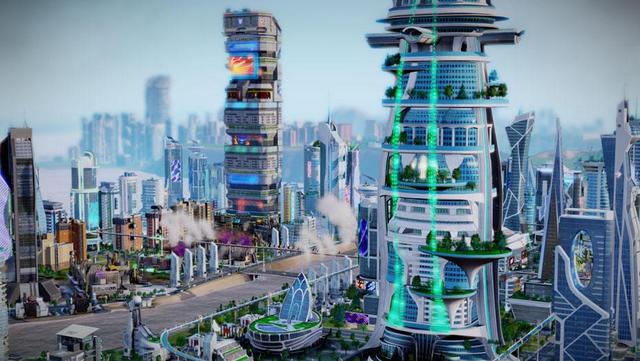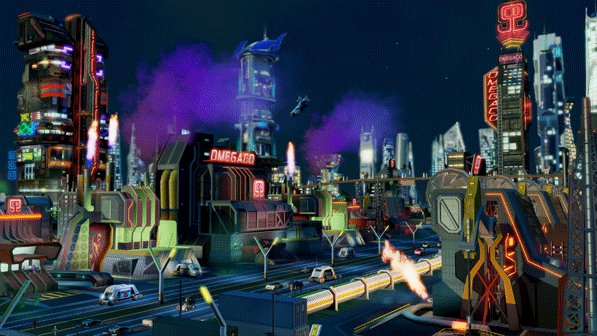On November 12th, a new expansion pack to SimCity will be introduced called “Cities of Tomorrow.” Users will be able to build cities in the future, about 50 years from now, that coexist side by side in the current game. In this not- so-distant future city, Sims commute to work on elevated Maglev trains, receive deliveries via drones, and watch their trash be converted to atoms. But the most drool-worthy aspect of this new expansion pack are the MegaTowers. MegaTowers are basically cities within a city, modeled after both modern and self-built high rise existence in Asia and South America. Sim City lead designer, Stone Librande, told us that the MegaTowers are a response to user feedback about multi-use zoning within a building.
The MegaTowers are built over time, section by section. Each provides different purposes: apartments for living, schools for learning, malls for shopping, and even indoor parks for a breath of “fresh” air. You could even put a roller coaster on top of your tower for tourism purposes. As urbanists, we asked Stone if it’s possible to create a self-sustaining tower and he said it nearly is–except for the need to process sewage and garbage off-site.

But SimCity is far from a walk in the park. In the expansion pack, the player takes on the role of CEO of a Bloomberg-esque mega corporation called “Omega-Co” which, for the sake of game play, reduces the role of the government in these cities. Omega-Co produces an ambiguous substance for which there is constant demand. However, this mystery substance is highly flammable and pollutes the city, infecting Sims. With this arrangement, the player is always torn between satisfying their citizens’ demands and polluting the air.
At the same time, there’s a central mission control center that also functions as a research facility. If this goes down, a lot of the new energy sources available like wind turbines, fusion reactors and underwater wave energy facilities will break down. In some ways this does mimic some of the design mistakes made by cities for emergency response (the Office of Emergency Management was located in the Twin Towers on 9/11). Stone tells us that players can create additional sub-control centers to lower risk of disaster, which in this future scenario includes a massive robot landing from the sky in search of raw materials.

On top of this, players have other major responsibilities. They have to figure out how to import power, water, and oil based on the geography of the city. And yes, oil prices fluctuate with the market as they do now. Omega can also be exported to other existing cities, even if those players/mayors don’t have the expansion pack.
A more futuristic aspect of the city is a building which can convert into a spaceship with enough funding. With the expansion pack, the player can put all prisoners into this spaceship and cast them off into the universe.
The idea of literally ridding your city of criminals feeds into the “Utopian” ideals perpetrated in SimCity, since its inception. During Comic Con, Untapped was given a preview of an actual”SimCity of the Future” in full bloom. This city was called a “Utopia.” One of the most defining features of this city was that the gleaming city which housed the wealthy sims was on one side of a river, and the more “working class” industrial part of the city was on the other side of this river. This city had accompanying MegaTowers for each neighborhood, because there are “elite” MegaTowers for the wealthy and a more self-built versions for the working class (think of the skyscraper in Caracas, Venezela that Seargant Brody was trapped in during the last episode of Homeland).
This separation of the rich and poor forces us at Untapped to consider the meaning of “Utopia.” It seems that the SimCity definition of a “Utopia” has a stark division of the classes, and a general avoidance of poverty. As Untapped Cities founder Michelle Young wrote in an article for video game magazine Kill Screen, in SimCity, when the Sims “are unable to accomplish their predefined loop, they become unhappy. Happiness can also be derived from safety, education and other factors” like shopping. Is this an aptly timed commentary on the Bloomberg administration? Or an interpretation on how the world “really works”? And do such visualizations come from our cultural fascinations with dystopias?
Regardless, like the current SimCity main game, the game is beautiful and the new features of “Cities of Tomorrow” certainly brings SimCity game play closer to the city of today and provides some intriguing suggestions about the city of the future.
For more reading on the SimCity check out our coverage of an urban planning competition hosted by SimCity in March at the launch of the new game. For a more theoretical interpretation of the game, read this article by Untapped Cities founder, Michelle Young.





